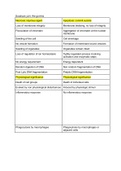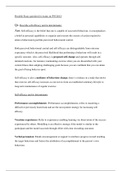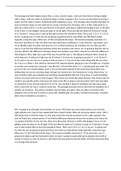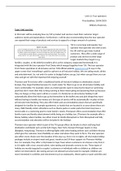P ROBLEM 4
1 a) What do people believe are cues to deception?
Pitch of voice: all groups expressed different views, most frequent answers were ‘no difference or I don’t know’
-Generally, people associate nervous behaviors with deception, but most of the typical nervous behaviors are
rarely shown by liars
-Most of the police officers subscribe to the belief that liars are more gaze aversive than truth-tellers.
-All groups expressed a very strong belief in the principle stating that deceptive consecutive statements are less
consistent than truthful consecutive statements. It should however be noted that there is more to consistency
than contradictions, e.g., omissions and commissions.
-Judges, prosecutors, and police officers believe deceptive statements to contain less details compared to truthful
statements.
-Police officers subscribed to the belief that there is an increase in body movements during deception.
Prosecutors and judges expressed a more diversified and careful view (for both groups the most used answer
alternatives was the ‘don’t know’, and ‘no difference’).
-Judges and prosecutors believed verbal cues to deception to be more reliable than nonverbal cues. Police
officers however tend to focus more on nonverbal cues when attempting to detect deceit.
-Interrogators/Observers: All three groups investigated strongly believe that a person who conducts an
interrogation will be more successful at detecting deception than will a person who watches the same
interrogation on video.
1 b) What are scientific cues to deception?
Strömwall &Granhag (2003)
- Pitch of voice: liars have higher pitched voice than truth tellers, probably due to stress
- Gaze Aversion: literature shows no relationship between gaze aversion and deception
- Number of details: truthful accounts are richer in detail than deceptive
- Consistency: previous research shows that deceptive statements are at least equally
consistent over time as are truthful statements
- Body movements: experimental research shows that liars often move less than truth tellers
- Verbal vs. Non-verbal cues: research shows lie catchers trusting verbal cues tend to achieve
higher accuracy scores than do lie-catchers trusting nonverbal cues
- Interrogators/Observers: those who observe are more accurate at detecting deception due
to the fact that an interrogator must spend cognitive energy monitoring both himself and the
suspect, and in addition make the appropriate conversational extensions
DePaulo et al. (2003)
-Liars are likely to experience a sense of deliberateness as they try to convey particular impressions
of themselves
, -Liars provided fewer details than truth-tellers (d=-0.30)
-When lying about a transgression, liars are tenser (d=.0.27) and less forthcoming
-Liars made less sense than truth tellers and were less plausible (d=-0.23); they were also less likely
to be structured in a logical way (d=-0.25)
-Liars seemed less involved verbally in their self-presentations compared to truth tellers (d=-0.21)
-They spoke in a higher pitch and were more vocally tense
-They also showed fewer of the gestures used to illustrate speech (d=-0.14)
-When there is no time to prepare a lie, liars are more likely to hesitate and have longer response
latencies (d=0.20)
-They also show fewer spontaneous corrections because they try to anticipate what a truth-teller
would do
-Liars also avoided to fail remembering something
-Estimates of eye shifts displayed a nonsignificant trend, yet liars had more dilated pupils
-Liars raised their chins more often
-Repetition of words produced a statistically significant effect
-Small relationship between posture shifts (e.g., hand/foot movements) and deceit
-Hardly any relation between nonverbal cues and deception
-Cultural/individual differences may be important to consider (e.g., one may be more confident in
looking in the eye)
OVERALL CONCLUSION
Nonverbal methods for detecting deception are often limited and unreliable
Barely identify deception above chance levels of accuracy
2) What is the effect of seeing on the credibility of the witness?
Leach et al. (2016)
Minimization of information principle - focuses observers on a limited number of diagnostic
cues. Niqabs should minimize the amount of information that is available to observers and
prevent them from basing their lie detection decisions on misleading facial cues. The veiling
of the witness might force observers to attend to sources of information that are more
diagnostic of deception, such as verbal content.
Reasons:
1 a) What do people believe are cues to deception?
Pitch of voice: all groups expressed different views, most frequent answers were ‘no difference or I don’t know’
-Generally, people associate nervous behaviors with deception, but most of the typical nervous behaviors are
rarely shown by liars
-Most of the police officers subscribe to the belief that liars are more gaze aversive than truth-tellers.
-All groups expressed a very strong belief in the principle stating that deceptive consecutive statements are less
consistent than truthful consecutive statements. It should however be noted that there is more to consistency
than contradictions, e.g., omissions and commissions.
-Judges, prosecutors, and police officers believe deceptive statements to contain less details compared to truthful
statements.
-Police officers subscribed to the belief that there is an increase in body movements during deception.
Prosecutors and judges expressed a more diversified and careful view (for both groups the most used answer
alternatives was the ‘don’t know’, and ‘no difference’).
-Judges and prosecutors believed verbal cues to deception to be more reliable than nonverbal cues. Police
officers however tend to focus more on nonverbal cues when attempting to detect deceit.
-Interrogators/Observers: All three groups investigated strongly believe that a person who conducts an
interrogation will be more successful at detecting deception than will a person who watches the same
interrogation on video.
1 b) What are scientific cues to deception?
Strömwall &Granhag (2003)
- Pitch of voice: liars have higher pitched voice than truth tellers, probably due to stress
- Gaze Aversion: literature shows no relationship between gaze aversion and deception
- Number of details: truthful accounts are richer in detail than deceptive
- Consistency: previous research shows that deceptive statements are at least equally
consistent over time as are truthful statements
- Body movements: experimental research shows that liars often move less than truth tellers
- Verbal vs. Non-verbal cues: research shows lie catchers trusting verbal cues tend to achieve
higher accuracy scores than do lie-catchers trusting nonverbal cues
- Interrogators/Observers: those who observe are more accurate at detecting deception due
to the fact that an interrogator must spend cognitive energy monitoring both himself and the
suspect, and in addition make the appropriate conversational extensions
DePaulo et al. (2003)
-Liars are likely to experience a sense of deliberateness as they try to convey particular impressions
of themselves
, -Liars provided fewer details than truth-tellers (d=-0.30)
-When lying about a transgression, liars are tenser (d=.0.27) and less forthcoming
-Liars made less sense than truth tellers and were less plausible (d=-0.23); they were also less likely
to be structured in a logical way (d=-0.25)
-Liars seemed less involved verbally in their self-presentations compared to truth tellers (d=-0.21)
-They spoke in a higher pitch and were more vocally tense
-They also showed fewer of the gestures used to illustrate speech (d=-0.14)
-When there is no time to prepare a lie, liars are more likely to hesitate and have longer response
latencies (d=0.20)
-They also show fewer spontaneous corrections because they try to anticipate what a truth-teller
would do
-Liars also avoided to fail remembering something
-Estimates of eye shifts displayed a nonsignificant trend, yet liars had more dilated pupils
-Liars raised their chins more often
-Repetition of words produced a statistically significant effect
-Small relationship between posture shifts (e.g., hand/foot movements) and deceit
-Hardly any relation between nonverbal cues and deception
-Cultural/individual differences may be important to consider (e.g., one may be more confident in
looking in the eye)
OVERALL CONCLUSION
Nonverbal methods for detecting deception are often limited and unreliable
Barely identify deception above chance levels of accuracy
2) What is the effect of seeing on the credibility of the witness?
Leach et al. (2016)
Minimization of information principle - focuses observers on a limited number of diagnostic
cues. Niqabs should minimize the amount of information that is available to observers and
prevent them from basing their lie detection decisions on misleading facial cues. The veiling
of the witness might force observers to attend to sources of information that are more
diagnostic of deception, such as verbal content.
Reasons:











